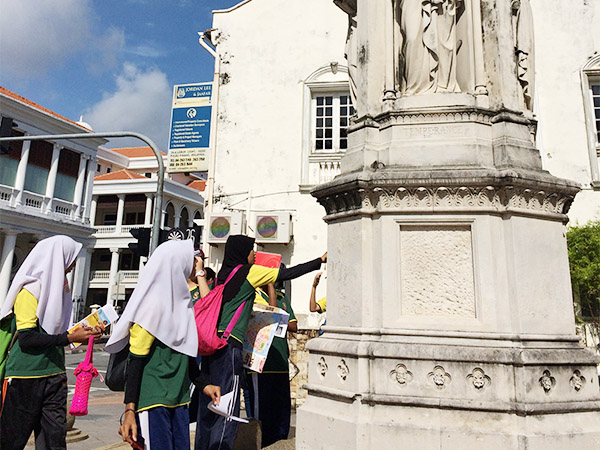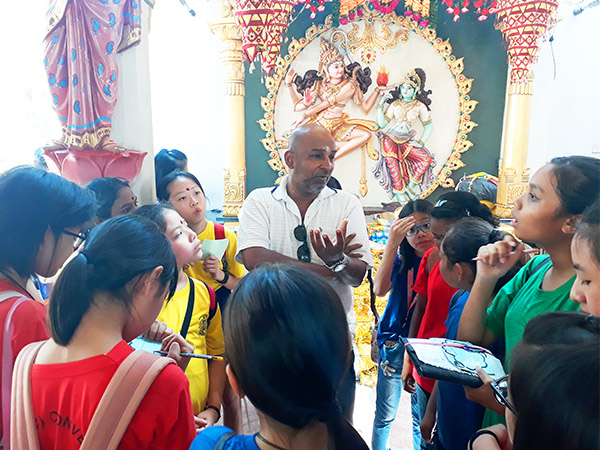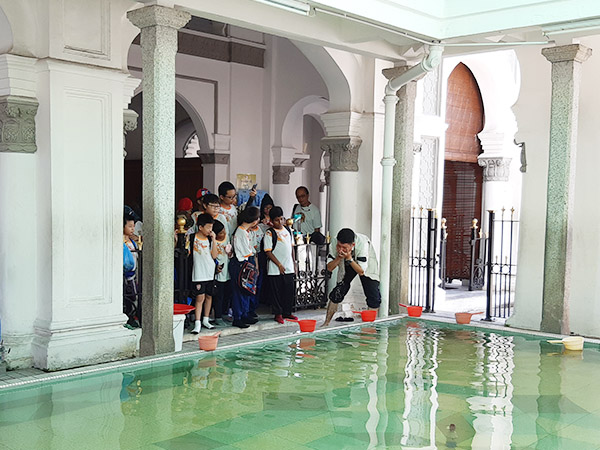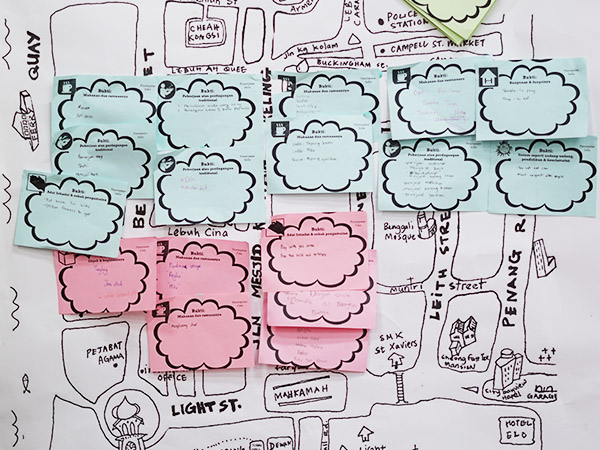Multicultural Legacies of Early Settlements
What do stories of migration and settlement tell us about ourselves and our collective identity? Participants go on an interactive guided walk around five historical settlements in George Town to explore each community’s living and built heritage.
Project at a Glance
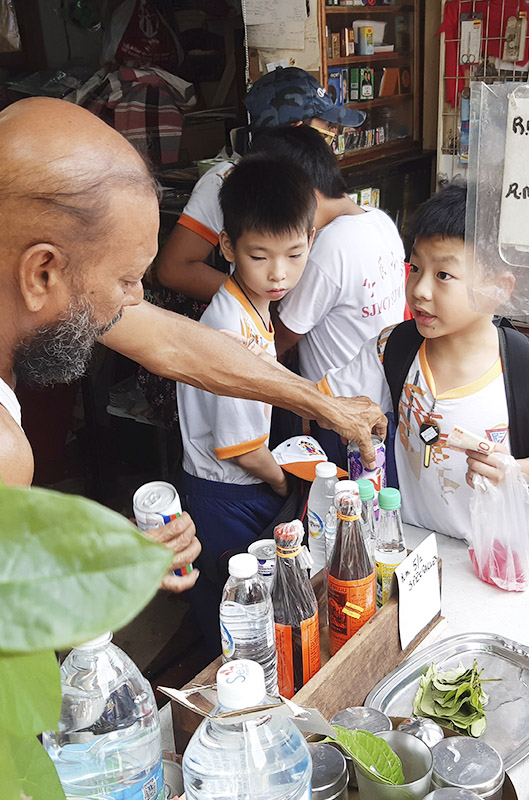
Driving Questions
What can we learn about ourselves and our identity as a society from the stories of different communities’ migration and settlement?
Creative Medium
Interactive and experiential walk
Community
5 historical settlements in George Town, Penang
Participants
11–15 year olds
Human Resources
A tour guide or someone who has cultural knowledge of the historical settlements, a facilitator
Timeframe
6 hours
Relevant Subjects
History, Geography

Knowledge
- Understand George Town’s multicultural history.
- Locate the different migrant settlements in George Town.
- Identify settlement patterns of George Town’s multicultural communities, including each community’s history, inherited customs/practices, buildings/architecture, food, and trades.

Skill
- Interview and interact with the community at the various settlements.
- Synthesise the information collected on a large settlement map.

Value
- Appreciate the diversity among the communities of the different migrant settlements.
- Appreciate that despite the diversity, different communities can interact and live harmoniously.
- Appreciate the need to safeguard the built and living culture of the respective migrant communities.
Suggested Activities:
- SCHOOL & FAMILY – Investigate and share your family migration stories and cultural background in class. This action promotes a sense of inclusivity and understanding of one another.
- SCHOOL & FAMILY – Create engaging presentations using the collective synthesised maps of the various settlements and information about historical migrant settlements, built heritage legacies, and other evidence collected during the interactive walk. Share these presentations with schoolmates, friends, and family to promote awareness and appreciation of living heritage.
- NEIGHBOURHOOD AND BEYOND – Publish editorials in local newspapers or online platforms highlighting insights gained from the Early Settlements interactive walk to reach a wider audience.
- NEIGHBOURHOOD – Organise cultural events that celebrate various cultures in the neighbourhood, such as performances, exhibitions or food festivals showcasing aspects of the discovered heritage from the interactive walk. The public or members of the community could be invited as guests.
Context and Citizenship

Migration and settlement have shaped the history and culture of societies around the world. Migration refers to the movement of people from one place to another, while settlement refers to the process of establishing a new community in a particular location. These processes have been occurring for centuries and play a significant role in shaping the cultural and social fabric of communities.
George Town, located in Penang, Malaysia, is a UNESCO World Heritage Site that is home to five historical settlements: the Malay (from Aceh, in particular) settlement, the Indian settlement, the Indian Muslim settlement, the Chinese settlement, and the European settlement. The migration of different communities to George Town played a crucial role in the cultural diversity of the city. These settlements were established during different periods of history, each with its unique cultural and historical significance.
Discovering the migration and settlement stories of different communities can provide valuable insights into our society’s identity. It can help us understand how our cultural identities have been shaped by migration and settlement and how this has contributed to the cultural diversity of our society. We can also learn about the challenges different communities faced during the migration and settlement process, such as adapting to new cultures, overcoming discrimination, and preserving their cultural heritage.
Components of Learning
Activity 1 - Cultural ID Card
Participants were first introduced to the concept of culture, which involves the shared practices and values of a group of people living in the same area over time. They were told that they would embark on a trail to explore and collect evidence for the cultural legacies of various ethnic groups that have settled in George Town.
Before the trail, participants reflected on their own cultural identity through the Cultural ID Card Activity. They paired up and drew a full-body picture of their partner on a blank piece of card. Alongside the picture, each participant interviewed their partner to gather information about each other’s cultural background, including their:
- name, ethnicity, religion, and languages spoken;
- three favourite dishes (written in the Mouth section of the card); and
- three cultural practices observed at home (written in the Hand section of the card)
Once completed, participants received their own Cultural IDs from their partners and shared them with two other participants. This activity aimed to help participants connect their own identity and cultural practices to the legacies they would observe on the trail.
Activity 2 - Pre-Walk Briefing
Before starting the walk, participants were given an overview using a map that shows the locations of the five migrant settlements in the George Town World Heritage Site. Participants were instructed to listen to the guide, observe, and interview residents as they explored the settlements.
The main task for the participants was to collect evidence for cultural legacies by jotting down notes based on the following categories:
- Food and their ingredients;
- Objects and what they are used for;
- Customs and why they are practised;
- Buildings and their functions;
- Systems like religion, law, schooling, banking, security, etc.; and
- Cultural trades and occupations.
At each settlement visited, participants were given a guided tour and then 10 minutes to explore and collect at least three specific pieces of evidence of the settler group’s tangible and intangible cultural heritage for each category as outlined in the documentation sheet. The facilitator checked-in with each group on their documented evidence before leaving each site.
Tips for Adaptation:
What can you do if you have limited time?
To save time, conduct the guided walk for all five settlements first, then assign different groups of participants to one or two settlements each to explore and complete the documentation sheets. Remind participants to assign specific roles to their group members, such as interviewer, note-taker, and timekeeper. After 30 minutes, gather all participants to collectively synthesise their information into a large settlement map.
If you don’t have much time, you can choose to only visit two, three, or four settlements depending on your specific objectives, as long as the participants are exposed to the legacies of different groups.
Available download(s) for activity:
Activity 3 - Interactive Guided Walk Stop 1 - European Settlement
Participants walked the European settlement and tried to visualise activities in the past while the guide provided historical facts and anecdotes. As participants explored the heritage buildings and memorials, a brief explanation was given about the history and legacy of the structures. They also discussed the St. George’s Anglican Church, its history, function, and architecture.
At the end of the guided tour, participants were asked to highlight the perimeters of the European settlement on their map handout. The facilitator drew their attention to the names of the roads and how road naming was a way of memorialising essential people or places. Participants then filled their documentation sheets by providing evidence of British/European cultural legacies still visible today.
Activity 4 - Interactive Guided Walk Stop 2 - Chinese Settlement
At the Chinese settlement, the guide explained the history of Chinese migration to Penang using a map to show their migration path from China. They explored the nearby Goddess of Mercy Temple, with the guide explaining the temple’s significance, architecture, and function. Participants observed worshippers’ practices and visited the Chinese shops selling prayer-related items such as joss sticks and flowers
Activity 5 - Interactive Guided Walk Stop 3 - Indian (Hindu) Settlement
Here the guide explained the migration history of the Hindu Indian community. Participants then explored the surrounding area and Sri Mahamariamman Temple to find different traditional Indian foods, religious practices, trades, languages, and clothes. The guide also explained the conventional money lending system practised by the Chettiar, a sub-group in the community. Participants observed some traders at work, such as the flower garland makers and the ottukedai.
Activity 6 - Interactive Guided Walk Stop 4 - Indian Muslim Settlement
Differentiating the Hindu Indians from the Indian Muslims, the guide explained the unique place of origin, religion, and lifestyle of the Indian Muslims. Participants then explored the jewellery trade which many Indian Muslims are involved in, and their religious complex, the Kapitan Keling Mosque, which also houses a mausoleum and religious school.
Activity 7 - Interactive Guided Walk Stop 5 - Malay (Acehnese) Settlement
At this settlement, the guide explained the history of the Acehnese people from Sumatra and how and why they migrated to George Town. The guide narrated this settlement’s golden age and the Acehnese community’s past contributions, then explained that the community had since dwindled in numbers, leaving empty buildings. Participants reflected on the importance of safeguarding the community and living culture.
Activity 8 - Synthesis Mapping
Participants were given a large blank map of the George Town World Heritage Site and were asked to complete the following tasks by placing their documentation sheets on the map:
- Collectively locate the five historical migrant settlement areas;
- Identify and label the built heritage legacies; and
- Add evidence of living culture collected from their handouts.
This exercise helped participants grasp an overview of the various settlements and process the data they had collectively gathered.
Activity 9 - Reflection on Cultural ID
After completing the map task, participants retrieved their Cultural ID Cards and were given coloured stickers, where each settlement was assigned a different colour.
The facilitator read out various items such as food, customs, and objects from the ‘cloud’ documentation sheets on the large map. If a participant had incorporated any of these items into their life, they would place a sticker of the corresponding colour on their Cultural ID Card and make a small note next to the sticker about what they had incorporated. For instance, a Chinese participant might place a green sticker (Malay culture) on their card and label it “nasi lemak” because it was a dish they liked to eat. Participants then shared their Cultural ID with their group members.
This activity helped participants connect their own lives with the legacies that they observed or experienced in the programme—they too participate in the practices, beliefs, and systems that have been passed down by the generations before them. Importantly, the legacies they inherited are not limited to their own cultural group; often the multi-coloured stickers on each participant’s cultural ID reminded everyone that we live in a multicultural society and we take part in each other’s cultures too.
Activity 10 - Final Reflection
Activity 11 - School Presentation
Although this activity was not carried out in the original project, educators are encouraged to do so to reinforce participants’ learning.
With the collective synthesised maps and other supporting evidence collected during the interactive walk, participants can share their knowledge about the different historical migrant settlements, the built heritage legacies, and evidence of living culture found at the respective settlements with others at their educational institutions. By doing this, educators can promote the importance of knowing one’s cultural heritage legacy and encourage respect for other cultures and the desire to promote values that can lead to a peaceful co-existence within communities.
How to Adapt

Community
What are some settlements around you that have tangible and intangible cultural assets for participants to explore and learn about the evolution of their history and culture?
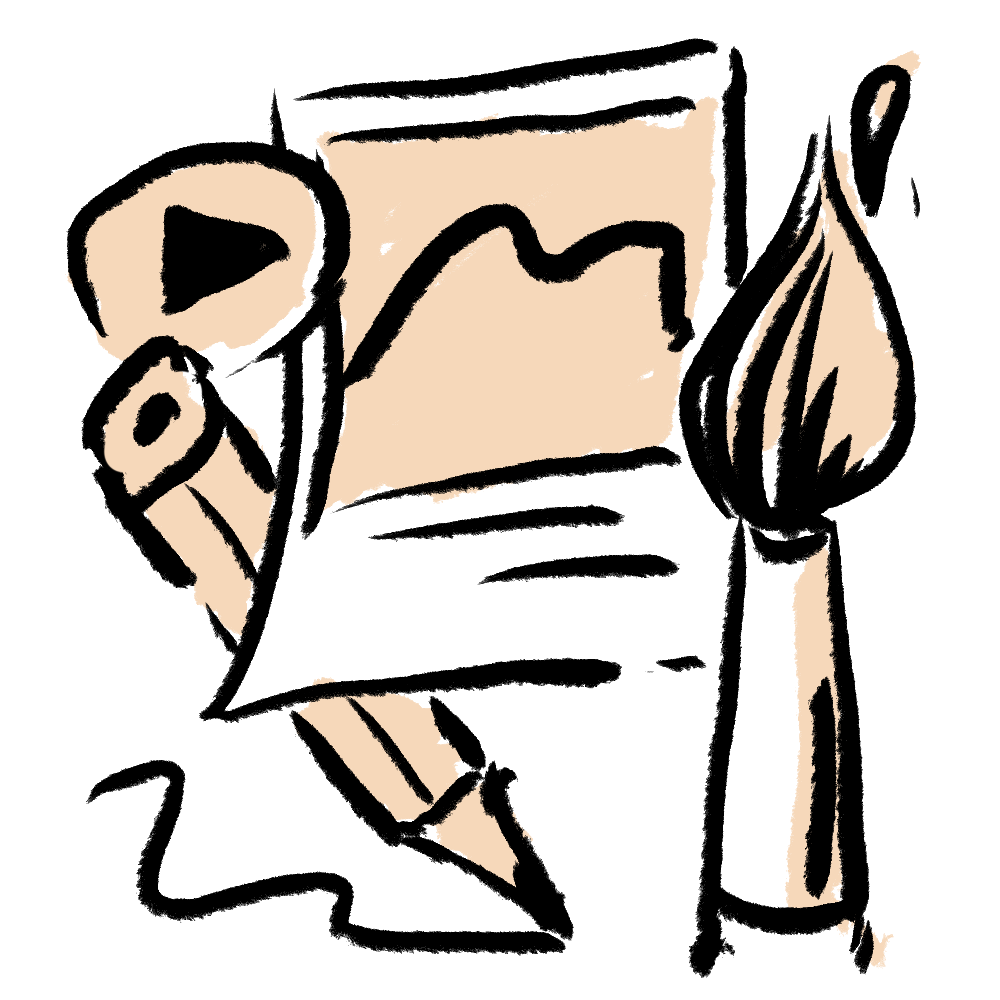
Creative Medium
Other than the interactive walk, you could consider conducting sessions before and/or after this programme to facilitate participants to connect to and reflect more deeply on their own identities and communities.

Topic
Going beyond discussing the broad cultural legacies of the site, you could narrow it down to a specific topic, perhaps by linking to a subject.
- For Geography – You could conduct a lesson on streetscapes, vistas, views, or landmarks that focuses on cultural aesthetics and philosophy. Consider comparing the unique design of urban settlements with settlements of the past.
- For Languages – Can you use any interesting personalities, events, activities, festivals, or buildings within the settlement as a lesson? Consider expanding the language skills that you want to impart. For example, an interview that students have to conduct would cover all four language skills, whilst witnessing an activity of making flower garlands could be converted into a process-writing lesson.
- For Art – Can you relate the school art syllabus to hands-on experience in the city? For example, you could increase appreciation of traditional design in local architecture by creating awareness of cultural symbolism in the decorative motifs of heritage buildings.
Originally conducted in Anak-Anak Kota and Cultural Heritage Education Programme (CHEP).
Additional Resources
For more on the heritage cultural resources available at the respective settlement sites, see A Teacher’s Guidebook: Bridging Global Citizenship and World Heritage https://www.gcedclearinghouse.org/sites/default/files/resources/World_Heritage_Guidebook.pdf





